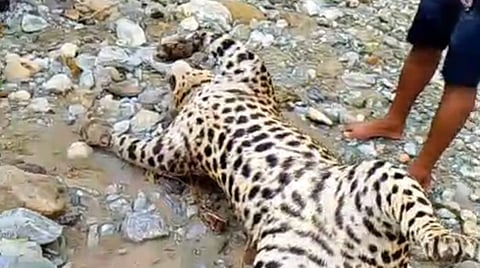

The Government of West Bengal is planning to set up high elevation disaster shelters for wild animals within the forests of the state’s north, after recent floods killed many animals in the region.
The department is planning to set up artificial highland areas in north Bengal’s forests, emulating the ‘Kaziranga Model’ on the lines of Assam’s Kaziranga National Park. These will provide safety to wild animals during future extreme weather events like what happened in north Bengal over the last weekend, a senior forest official told this correspondent on October 9, 2025.
Incidentally, north Bengal, like Kaziranga, is the habitat of Bengal tigers, Indian elephants, one-horned rhinoceros, leopards, wild buffalo, and gaur.
The extremely heavy-to-very heavy rainfall, in the range of 270 to 370 millimetres in several places over 15 hours during the last weekend, had created a flood-like situation in several districts of north Bengal. Millions of people and wild animals were impacted.
“Post the latest deluge and flood-like condition because of intense continuous rain over several hours, we are planning to set up raised mud platforms and highland areas within north Bengal forests where animals can quickly relocate themselves during future flood-like situations within forest areas. These will broadly be structured in line with the similar highland areas being built up within Kaziranga,” Bhaskar J V, chief conservator of forests (wildlife) for north Bengal told this correspondent on October 9. “We have seen the Kaziranga highlands. We plan to build similar artificial highlands across all forests in the coming years, based on our local requirements and situation,” added Bhaskar.
“As these will be mud platforms, the cost will not be very high. We intend to build several such platforms in due course of time within all forests of north Bengal. We will start working on the programme once we can settle down post the recent disaster,” added the official.
“We welcome the proposal. If one looks closely at the topography of north Bengal’s forests, while animals have access to natural highlands in Buxa, Mahananda and Chapramari, such highlands are not available in Jaldapara and Gorumara,” observed Anujit Basu, a wildlife expert from north Bengal.
Sonali Ghosh, director of Kaziranga, pointed out that the model has been successful in Assam’s premier protected area. “Highlands serve as a temporary measure for animals to take shelter during high floods. Roads, embankments and artificially created highlands have been effective in Kaziranga,” said Ghosh on October 10. She added that around 150 such highlands have been built over the last 15 years.
“Kaziranga National Park uses 144 human-made highlands and 8.5 km of road-cum-highlands to provide refuge for animals during annual floods …” reads the national park’s website that gets submerged regularly during the monsoon.
The website further points out that “around 90 percent of the Kaziranga National Park” gets affected during the flood; and adds that during floods “the animals from the park (move) out to highlands … walk out through the animal corridors and entire stretch of the national highway”.
“The highlands, many in the range of one to one-and-half kilometres and even more, are playing a very important role in protecting animals during floods. Tigers, rhino, wild buffalo and elephants congregate during the flood on these highlands. It is a sight to behold. Broadly, 50 per cent of Kaziranga’s animals take refuge on the highlands during floods now and the rest mostly come out on a national highway that cuts through the park and migrate to adjoining areas,” observed Nazimul Haque, a local safari conductor.
“The situation has stabilised to a large extent. But clearly, the north Bengal forest area has been impacted though there has not been significant loss. However, we have not yet been able to enter remote areas of the forest and assess the actual loss,” Bengal forest minister Birbaha Hansda told this correspondent recently.
Officials said the floods have affected parts of Buxa Tiger Reserve, Jaldapara National Park and Gorumara National Park; both Jaldapara and Gorumara are important habitats for the one-horned Indian rhino.
“As per our records, two rhinos died in Gorumara from flooding in the Jaldhaka river. One got washed away about 140 km to Bangladesh while the other was found 14 km away. Apart from that, one leopard, 17 gaur and two deer died in Jalpaiguri,” said Bhaskar. The official added that apart from animals, infrastructure including four bridges and solar panels got damaged, while the forest area has been significantly impacted due to mud spills. “Further inquiry is on to assess the actual damage,” said Bhaskar.
While the forest department sought to underplay the deluge-triggered devastation on north Bengal’s wildlife, local animal activists pointed out that the actual wildlife loss is expected to be higher as more carcasses are retrieved as water gradually recedes within the forests.